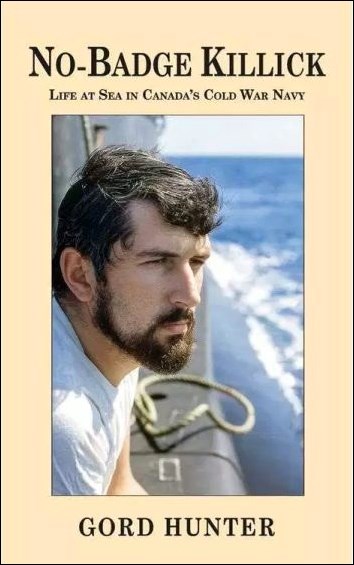By Gord Hunter
Published by Monkey's Fist Publishing
$20.00 ISBN 978-0-9681803-1-0
Talk about adventures on the high seas. Gord Hunter hits the mark in No-Badge Killick: Life at Sea in Canada's Cold War Navy, where some of his adventures take place under the seas.
Sailors in Commonwealth navies refer to a leading seaman as a killick, originally the name given to a small anchor. After serving at least three years without getting into trouble, a sailor is entitled to wear a good conduct badge. If a leading seaman commits a major breach, he loses his good conduct badge, thus becoming a no-badge killick.
In 1962, after his high school principal tells him not to bother returning, Hunter enlists in the Royal Canadian Navy. He's only 17. He barely completes his basic training before being assigned to a ship during the Cuban missile crisis that fall, at the height of the Cold War.
Hunter trains as a sonar operator, learning how to detect and track Soviet submarines and spy ships. The highly sensitive equipment is top secret and on one occasion he has to order a senior officer out of the room because sonar operations are strictly on a “need to know” basis.
Serving on a frigate and escort destroyers, Hunter relates the routine of life at sea: learning how to tie knots such as the monkey's fist; participating in the traditional daily ration of rum; visiting bars in foreign ports, some with “No Dogs or Sailors Allowed” signs; and nearly being swept overboard. Other experiences include overextending shore leave and watching his ship sail off without him and getting stuck on an ice floe. He experienced tanding lookout with cold Atlantic sea spray splashing his face and the warm Caribbean with its own hazards.
While anchored off the island of St. Thomas, Hunter and a buddy try fishing from the stern. They catch “a five-foot, decidedly unhappy shark,” flopping wildly and haul it almost to the deck. As the ship is weighing anchor, they struggle to free the hook, “but no one was going to stick a hand into that shark's mouth.” Hunter , “the Captain would not be happy if we sailed with a shark hanging off our stern.”
Hunter witnesses some epochal events in recent Canadian history. He's there in 1965 when Canada unveils its new, and controversial, maple leaf flag. He participates in anniversary celebrations for Canada's Centennial in 1967. And he's there when Minister of National Defence Paul Hellyer announces the even more controversial unification of Canada's Armed Forces.
In 1968, Hunter switches to the submarine service, revealing several peacetime instances of submarines sinking, including an American nuclear sub that lost its entire crew. During one exercise, Hunter's skipper orders the sub to dive to 200 feet. Because of a faulty mechanism, it keeps going. As the helmsman frantically pulls back on the controls, the sub continues its dive.
No-Badge Killick `s seafaring stories provide an intriguing look at a Canadian sailor's life during the Cold War. Hunter now resides in Regina, surrounded by a sea of wheat.
— This book is available at your bookstore or from www.skbooks.com




